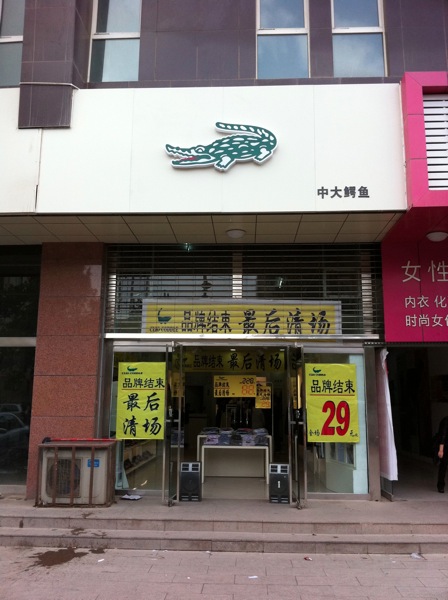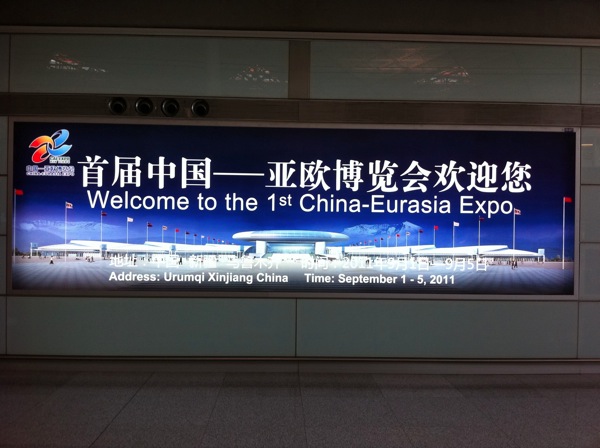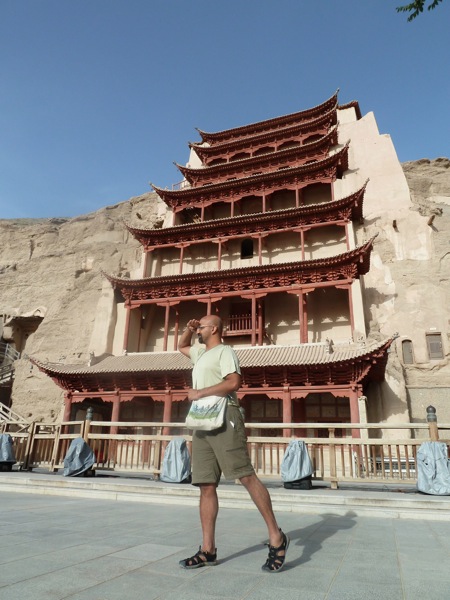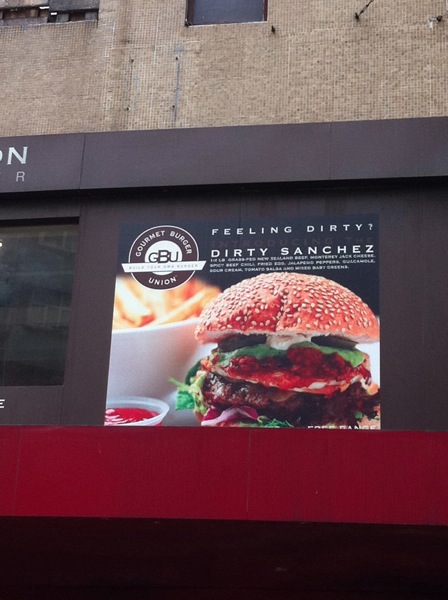This post is a brief collection of thoughts and impressions that didn’t fit into my in depth and more thoughtful (I hope) post on China (see above). I recommend that one if you’re only going to read one of my China posts. But if you prefer little tidbits sized chunks of randomness from my month in the PRC, here they are! (Also, if you want to just look at my PICTURES, click here.)
As I said in my other post: I hope I don’t offend anyone (esp. my Chinese friends) with my thoughts and impressions – I really am just trying to understand what I saw & felt while in a fascinating and very different place.]
- Unsurprisingly, knockoffs of Western brands were plentiful but this is my MOST FAVORITE ONE EVAR: I give you Clio Coddle.
When I first saw it I simply chuckled, but something about the name really stuck with me and I had to think about it for a few minutes. Suddenly I realized the “Clio Codile” was probably an Asian L-R-switch attempt to pronounce “Crocodile” – it is simply a filtered onomatopoeia! This cracks me up no end.

- Historical repeating: My lovely assistant, Tom Radulovich, had given me a good book on Chinese history (John Keay’s “China: A History”) which I was reading on the trip, & it helped us appreciate the other most interesting theme of our trip: the constant sense of history repeating itself along our way:
- Hist. Repeating I: The fact that we were following in the path of the Silk Road in our travels was definitely a theme, but it was remarkable in that the FIRST ad we saw as we got off the plane in Beijing was a giant sign for the “1st China-Eurasia Expo” in Urumqi, our penultimate destination. This trade show was clearly the modern echo of the Silk Road, underscoring the importance of trade with Central Asia and points west, now as much as then.

- Hist. Repeating II: Additionally it was the security for this trade show that gave the Urumqi it’s “occupied” feel. Many, many troops (and even more disturbingly, what appeared to be local citizen’s militias) were on hand to prevent Uighur separatists from causing an incident. Chinese history is full of Emperors sending troops to the West to curb unrest & discontent & this felt as yet another episode.
- Hist. Repeating III: Similarly, though more pleasantly, there was a fascinating sense of continuity as we visited the famous Magao caves near Dunhuang, known for their impressive carved stone buddhas and paintings. These artworks have been funded throughout their history by wealthy individuals of the day, for some combination of reasons such as religious commitment, as status symbols, and out of a sense of philanthropy. In fact, the faces of these benefactors were often painted in as characters in the artwork. Notably, as we exited the site, there were large placards with photos of wealthy benefactors of today, detailing their donations for the restoration and upkeep of the site, no doubt for reasons not so dissimilar.
- Hist. Repeating IV: At the same site, there were historic structures which had been refurbished by the Chinese government fairly recently for purposes of tourism. At first I was appalled at the lack of respect for the historical purity of these structures. Soon thereafter, it was explained that those structures had been refurbished for the first time since the last time they were refurbished in the 1920s. And presumably they had been refurbished before that, and before that stretching back since they were originally constructed. So was restoring them making them somehow less historical, or somehow more historical in that light?

- Highlights: (many of these are covered in my PICTURES)
- Hutongs in Beijing
- Beijing architecture
- Xi’an city wall bike ride
- Xi’an night market & food
- train rides
- Terra Cotta Warriors (& hopefully Emperor Qin’s tomb someday soon!)
- The sand dunes in Dunhuang
- Magao Caves
- The Old Town in Kashgar & eating fresh naan & melons (for which Xinjiang is famous)
- Roaming Shanghai by bicycle
- the City Planning Museum in Shanghai: a scale model of the entire city, always kept up to date! Urban Planning Geek out!
- I have often wished I could have seen China when the bike was king, but those days are gone sadly. That being said, there are still plenty of bicycles and utility tricycles all over China.
- a huge percentage have been converted to electric bikes by after-market electric motors. Almost all the utility trikes were electric.
- Every bike rental we ever had (other than Shanghai Bike Share) was a totally crappy bike 🙁
- The much trumpeted Shanghai Bike Share program, was, like many things in Shanghai, incredibly useful on paper, but all the implementation details pointed to the fact that the program was really just for show. The bikes were decent though and worked well for what I needed – so thank god for that!
- As much as I give chain stores a bad rap, Starbucks became a big part of the trip for us & were very much appreciated wherever we found them: You could pretty much always count on free Wifi, and more importantly they were often the coffee shop that you could find as a tourist that was guaranteed to be relaxing & mellow. There didn’t seem to be a lot of “local options,” though when we found them we certainly appreciated them too – but of course they always allowed smoking indoors. Super-bleech.
- Facebook is blocked in China but (except, I’m told, in high end hotels that cater to foreigners, so they don’t notice the issue.) but luckily proxy websites are easy to find that worked around this issue.
- The Chinese grow food EVERYWHERE, even in freeway medians. Unfortunately it is mostly low-grade feed corn, mostly for pigs. China loves pork!
- While we were flying over the Western regions I noticed theses strange large scale patterns in the terrain, that were obviously man-made, but I couldn’t figure out what the hell they were. Gizmodo and others are now reporting similar mystery structures – check it out!
- China foolishly squanders money that any sane nation would use to pay for oil wars in the Mideast by investing heavily in energy technology and national infrastructure. Every stop in the west had a vast new airport & new construction was rampant.
- Throughout China, though especially in more affluent Beijing & Shanghai, Apple was everywhere. iPads and iPhones are *THE* thing. Buy stock. Seriously. (yes, I work for Apple, but I mean it nonetheless.)
- On a related note, I was really struck by how much of the dominant technology I was seeing in the advanced, more affluent parts of China were Western technologies: laptops, cellphones, TVs, iPads, cars. Most of them 20th century technologies. How long will this be the case? Will this hegemony of innovation continue? Will it equalize? Will it shift to Chinese/Indian dominant in the next century?
- Every square inch of of “new” in China seemed to be a mall, or a facility “with a mall built in!” Â K suggests that in the absence of religion, consumerism has filled the gap. It certainly looked that way to me. Â Sigh.
- The two biggest pieces of advice I can give a traveller to China are:
- For the love of god, bring a bed roll (like a camping Thermarest). The beds in all but the highest end hotels are hard wood slabs covered by a cruel taunt of a pad. I mean it: Thermarest.
- Though it will seem innocuously amusing at first, do NOT read the English-language t-shirts that everyone wears. Although it is fascinating to see literally millions of people wear t-shirts in a language only a few of them understand, and although some are amusing, eventually you won’t be able to stop reading them. Â Then you will accidentally read something out of the corner of your eye, that will cause your brain to lock up. Or you’ll read things that are unintentionally disgusting – to wit (google it at your own risk):
 Actually, this was taken in Hong Kong, outside a burger joint advertising it’s newest “delicacy.”
Actually, this was taken in Hong Kong, outside a burger joint advertising it’s newest “delicacy.”
- I’m afraid to consider Chinese pop music. On most trips to most countries I’ve been to, there has been some sense of local popular music that was at least intriguing. Not China. Every single pop song I heard (or watched on ubiquitous video screens) was a truly horrible syrupy pop ballad of the worst Western style. My kingdom for something with more emotional range than a Hallmark card sent by a 15 year old girl.
- On a related note though, it was really cool to see that Chinese pop culture was beginning to get a sense of its own value. In various more hip shopping districts such as Nan Louguxiang in Beijing, Tai Kang Lu in Shanghai & the Hong Kong chain Shanghai Tang, there was a really cool burgeoning sense of “Cool Intrinsically Chinese things” or cool mashup “Western Meets Chinese” things where both sides had equivalent value. That made me really happy.
- I had a fascinating conversation with a man in Kashgar who explained that most people used to eat donkey meat because it was so cheap, but then had to start sending it all to Beijing for the 2008 Olympics. He then explained that the price had never returned to normal, so now they don’t eat as much of it: As impressive as the Beijing Olympics were (& wow were they), they were willing to impoverish their entire country to stage them.
Gateway at the Magao caves, built ? refurbished in the 1920s and now again in 2011…
